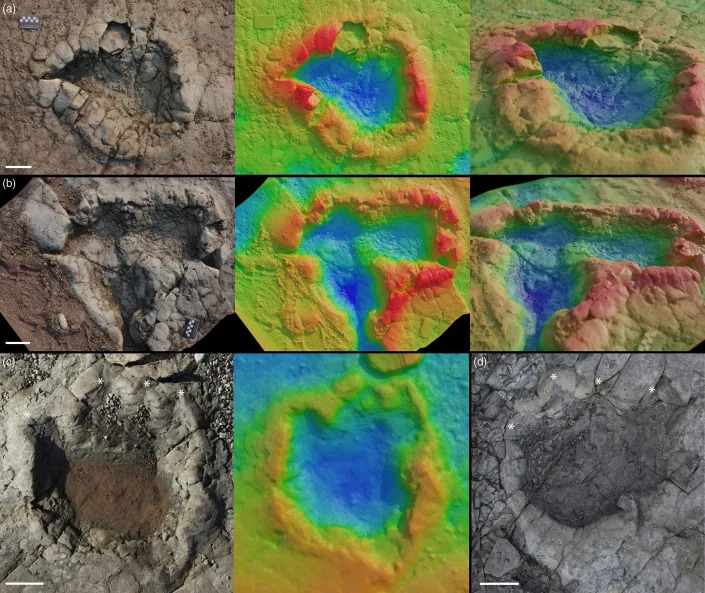200-million-year-old dinosaur footprints discovered on beach
Scientists say that 1.6-foot-long impressions discovered on a beach in Wales may actually be footprints of dinosaurs. The "rare" tracks, they said, are 200 million years old, indicating that dinosaurs from the late Triassic period once roamed the area.
The footprints were found by a member of the public near the shoreline on a beach at Penarth in 2020 and reported to London's Natural History Museum. Paul Barrett, a palaeobiology researcher at the museum, helped lead a study of the tracks, which was published in Geological Magazine on December 29.
Individual tracks of course were much nicer models. Also, all the photos and models are freely available as supplemental info! And the Paper and data are #openaccess pic.twitter.com/JH8Y0FyDH9
— Peter Falkingham (@peterfalkingham) December 30, 2021
The tracks discovered are within a roughly 164-foot long area, with each measuring up to roughly 1.6 feet long, scientists said. The impressions, though "poorly preserved," have marked displacement rims and are regularly spaced apart, indicating that they are footprints rather than rock structures.
The number of prints also indicates it might have been a "trample ground" for dinosaurs, researchers said in their study.
"There are hints of trackways being made by individual animals, but because there are so many prints of slightly different sizes, we believe there is more than one trackmaker involved," Barrett said in a museum press release. "These types of tracks are not particularly common worldwide, so we believe this is an interesting addition to our knowledge of Triassic life in the UK. Our record of Triassic dinosaurs in this country is fairly small, so anything we can find from the period adds to our picture of what was going on at that time."
A series of tracks on a public beach point to the presence of large, long-necked dinosaurs in Wales over 200 million years ago. The Penarth footprints are believed to have been left by sauropodomorphs, a group which includes the iconic Diplodocus 🦕 https://t.co/i4ef9WM8jk
— Natural History Museum (@NHM_London) December 31, 2021
The researchers said they can't say with certainty what kind of dinosaur created the tracks, but that they believe it may have been a kind of a biped sauropodomorph, a long-necked herbivorous dinosaur known to be among the largest that roamed the Earth.
The museum said the specific dinosaur could have been similar to the Camelotia, whose fossils have been discovered in Southwest England from rocks dating back to a similar period.
Photos of the tracks appear to show digit impressions, but the tracks are "highly weathered," researchers said, making it "difficult, or even impossible, to determine if they were all made by the same taxon, or by several species."
What they did find, however, is that the tracks were formed in the late Triassic period between 237 and 201 million years ago.
"We think the tracks are an example of Eosauropus, which is not the name of a particular dinosaur species but for shape of a type of track thought to have been made by a very early sauropod or a prosauropod," Barrett said. 'We know these kinds of dinosaur were living in Britain at the time, as bones of the sauropod Camelotia have been found in Somerset in rocks dated to the same age."
The tracks analyzed have been exposed several times over the past decade, the researchers said, and have been noted by multiple members of the public. Some of the researchers started to formally document the tracks in 2009, creating models and mapping the site, but their work went unpublished and was not further disseminated until now.
Dinosaur footprints found on beach in Wales may be 200 million years old, researchers say

No comments:
Post a Comment